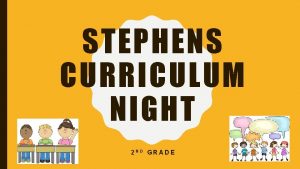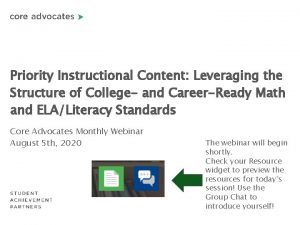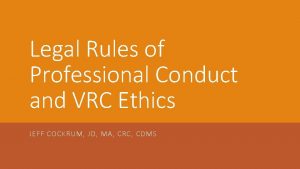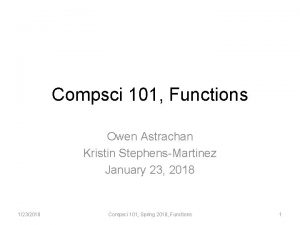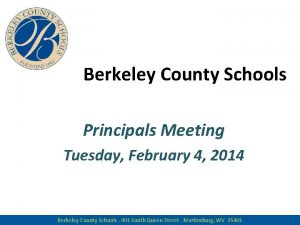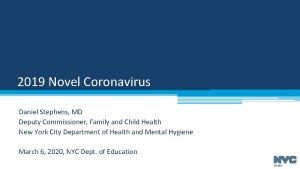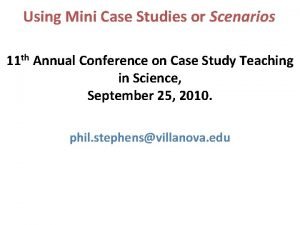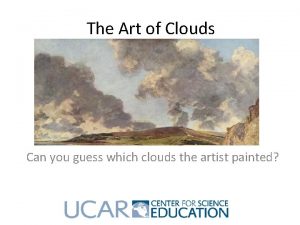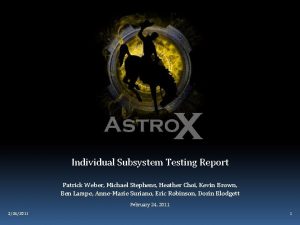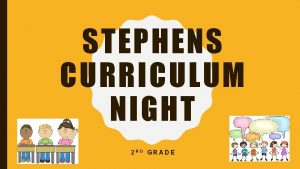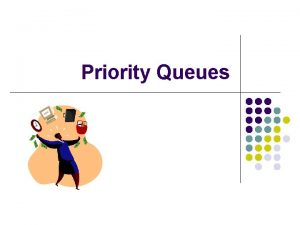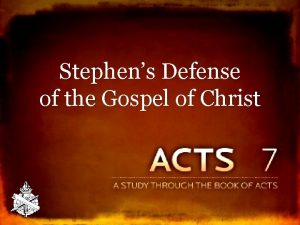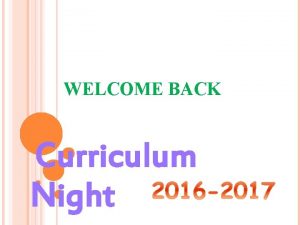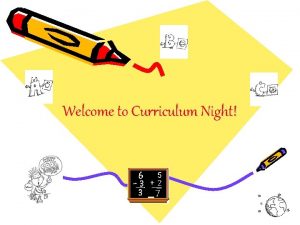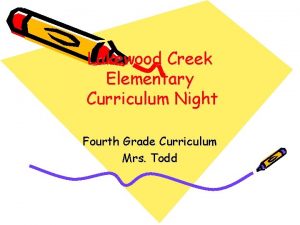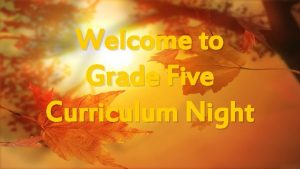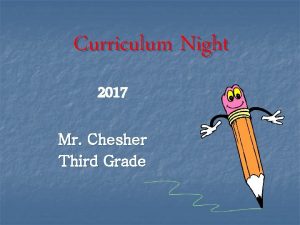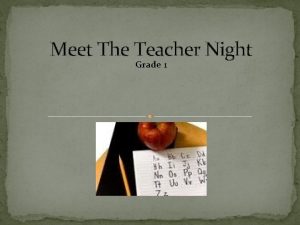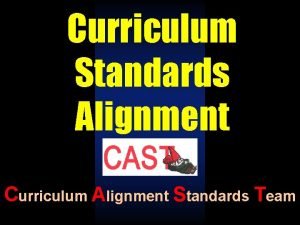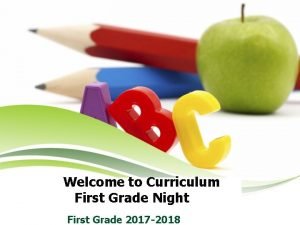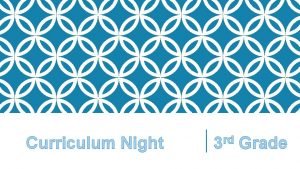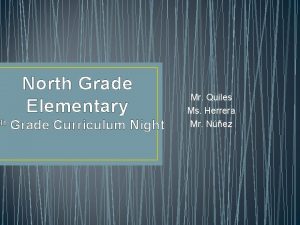STEPHENS CURRICULUM NIGHT 2 ND GRADE PRIORITY STANDARDS



















- Slides: 19

STEPHENS CURRICULUM NIGHT 2 ND GRADE

PRIORITY STANDARDS: MATH 2. NBT. 1 -Understand that the three digits of a three-digit number represents amounts of hundreds, tens and ones. Understand the following as special cases 100 can be thought of as a bundle of tens — called a “hundred. ” The numbers 100, 200, 300, 400, 500, 600, 700, 800, 900 refer to one, two, three, four, five, six, seven, eight, or nine hundreds(and 0 tens and 0 ones). 2. NBT. 2 -Count forwards and backwards within 1000; skip-count by 5 s, 10 s and 100 s 2. NBT. 3 -Read and write numbers to 1000 using base-ten numerals, number names and expanded form. 2. NBT. 4 -Compare two three-digit numbers based on the meaning of the hundreds, tens and ones digits, using >, =, and < symbols to record the results of the comparisons 2. OA. 4 -Use addition to find the total number of objects arranged in rectangular arrays with up to 5 rows and up to 5 columns; write an equation to express the total as a sum of equal addends. 2. NBT. 5 -Fluently add and subtract within 100 using strategies based on place value, properties of operations and/or the relationship between addition and subtraction.

CONT. . MATH PRIORITY STANDARDS 2. NBT. 7 -Add and subtract within 1000. Represent and solve addition and subtraction problems using: concrete models or drawings; strategies based on place value; properties of operations; the relationship between addition and subtraction and; relate drawings and strategies to expressions or equations. b. Understand that in adding or subtracting three-digit numbers, one adds or subtracts hundreds and hundreds, tens and tens, ones and ones; and sometimes it is necessary to compose or decompose tens or hundreds. 2. NBT. 8 -Mentally add 10 or 100 to a given number 100– 900 and mentally subtract 10 or 100 from a given number 100 -900. NBT. 9 -Explain why addition and subtraction strategies work, using place value and the properties of operations. 2. MD. 1 -Measure the length of an object by selecting and using appropriate tools such as rulers, yardsticks, meter sticks and measuring tapes. 2. MD. 4 -Measure to determine how much longer one object is than another, expressing the length difference in terms of either a customary or metric standard length unit.

CONT. . MATH PRIORITY STANDARDS 2. OA. 1 -Use addition and subtraction within 100 to solve one- and two-step word problems involving situations of adding to, taking from, putting together, taking apart and comparing, with unknowns in all positions, by using drawings and equations with a symbol for the unknown number to represent the problem. 2. OA. 2 -Fluently add and subtract within 20 using mental strategies. 2. MD. 7 -Tell and write time from analog and digital clocks to the nearest five minutes, using a. m. and p. m. 2. MD. 8 -Solve word problems with adding and subtracting within 100, (not using dollars and cents simultaneously) using the $and ¢ symbols appropriately (not including decimal notation). 2. MD. 6 -Represent whole numbers as lengths from 0 on a number line with equally spaced points corresponding to the numbers 0, 1, 2, . . . and represent whole-number sums and differences within 100 on 2. MD. 10 a number line. a pictograph and a bar graph (with single-unit scale) to represent a data set with up to Create four categories. Solve simple put together, take-apart and compare problems using information presented in a bar graph.

PRIORITY STANDARDS: READING/WRITING 2. RF. 3 -Know and apply grade-level phonics and word analysis skills in decoding words. Distinguish long and short vowels when reading regularly spelled one-syllable words. Know spelling-sound correspondences for additional common vowel teams. Decode regularly spelled two-syllable words with long vowels. Identify, decode and know the meaning of words with the most common prefixes and derivational suffixes. Identify words with inconsistent but common spelling-sound correspondences. Recognize and read grade-appropriate irregularly spelled words. 2. RL. 1 -Ask and answer such questions as who, what, where, when, why and how, and make and support logical inferences to construct meaning from the text. 2. RL. 2 -Identify implicit and explicit information from a summary to determine the author’s message, lesson learned and/or moral, including but not limited to fables and folktales from diverse cultures. 2. RL. 3 -Describe how characters in a story respond to major events and challenges in order to make meaning of the story development. 2. RL. 5 -Describe how parts of the text contribute to the overall structure of poems, stories and dramas, including notanswer limitedsuch to linear, non-linear andwhat, circular structures. 2. RI. 1 -Askbut and questions as who, where, when, why, and how, and make and support logical inferences to construct meaning from the text. 2. RI. 2 - Identify implicit and explicit information from a summary to determine the central idea of a text.

PRIORITY STANDARDS: READING/WRITING 2. RI. 6 -Identify the main purpose of a text, including what the author wants to answer, explain or describe, and how that purpose shapes the content of the text. 2. RI. 7 -Identify information gained from visuals and words in the text, and explain how that information contributes to understanding of the text. 2. RI. 9 -Describe the relationship between information from two or more texts on the same theme or topic. 2. C. 1 -Compose opinion pieces, using a combination of writing and digital resources, on topics or texts, with supporting reasons. (NOTE: Students must have the opportunity throughout the year to utilize digital resources, but not every writing experience must utilize those digital resources. ) With guidance and support from adults, strengthen writing through peer collaboration and adding details through writing and/or pictures as needed. Introduce the topic, followed by opinion statement, and create an organizational structure. Provide reasons with details to support the opinion. Use grade-appropriate transitions. Provide a concluding section. With guidance and support from peers and adults, develop and strengthen writing as needed by planning, revising and editing.

PRIORITY STANDARDS: READING/WRITING 2. C. 2 -Compose informative and/or explanatory texts, using writing and digital resources, to establish a topic and provide information about the topic. (NOTE: Students must have the opportunity throughout the year to utilize digital resources, but not every writing experience must utilize those digital resources. ) With guidance and support from adults, strengthen writing through peer collaboration and adding details through writing and/or pictures as needed. Introduce the topic. Supply information with detail to develop the topic. Use grade-appropriate conjunctions to develop text structure within sentences. . Use grade-appropriate transitions to develop text structure across paragraphs. Provide a concluding section. With guidance and support from peers and adults, develop and strengthen writing as needed by planning, revising and editing.

PRIORITY STANDARDS: READING/WRITING 2. C. 3 -Compose narratives, using writing and digital resources, to develop real or imagined experiences or multiple events or ideas, using effective technique, descriptive details and clear sequences. (NOTE: Students must have the opportunity throughout the year to utilize digital resources, but not every writing experience must utilize those digital resources. ) With guidance and support from adults, produce writing in which the development and organization are appropriate to task and purpose. Recount a single event or multiple events, memories or ideas. Include details which describe actions, thoughts, emotions. Use temporal words and phrases to signal event order. Create a sense of closure. With guidance and support from peers and adults, develop and strengthen writing as needed by planning, revising and editing. 2. C. 5 -Conduct shared research and writing projects that build knowledge about a topic. 2. L. 2 -When writing: Capitalize proper nouns, including but not limited to holidays, product names and geographic names. Demonstrate appropriate use of commas in varied communication formats (e. g. , letter, email, blog). Use apostrophe to form contractions and possessives. Generalize spelling patterns. Use reference materials to self-check and correct spelling.

PRIORITY STANDARDS: READING/WRITING 2. L. 4 -Determine or clarify the meaning of unknown and multiple-meaning words and phrases based on grade 2 reading and content, choosing flexibly from an array of strategies. Use sentence-level context as a clue to the meaning of a word or phrase. Determine the meaning of the new word formed when a known prefix is added to a known word. Use a known root word as a clue to the meaning of an unknown word with the same root. Use knowledge of the meaning of individual words to predict the meaning of compound words. Use glossaries and beginning dictionaries to determine or clarify the meaning of words and phrases. Use words and phrases acquired through conversations, reading and being read to, and responding to texts, including using adjectives and adverbs to describe.

PRIORITY STANDARDS AND PACING GUIDES

2 ND GRADE MAJOR TOPICS • Reading • Writing • Math • Science • Social Studies • Leader in Me (LIM) *See Priority Standards

HOW TO HELP YOUR STUDENT AT HOME • • • Read with them every night Practice sight words/ skill bags Counting Check & empty yellow folder Addition and subtraction facts Practice spelling words Math Manipulative Bags Resource Binders Handwriting Lexia/Dreambox Have your child explain their thinking to you Xtramath. com- you can create an account for your child

SUGGESTED DAILY READING TIME AND STRATEGIES • Read 10 -15 minutes • Retell the story • Ask questions • Beginning/ middle/ end • Characters, setting, problem solution • Connections (text-to-self, text-to-world, text-to-text)

PROCEDURES • Be safe • Be respectful • Be responsible *All of these are expected in the following places: -Classroom -Bathroom -Hallway -Cafeteria -Playground -Assemblies

REPORT CARDS AND GRADES • Dates: 4 times per year • AS: Area of Strength- 4 (I can teach the skill to someone else) – Independent mastery of skill • SP: Satisfactory Progress- 3 (I understand the skill and can work through it independently) – Where students should be in the year according to their grade level. • PH: Progressing with help- 2 (I need help completing the task) – Working towards a skill but might still need guidance and support (very normal to see some of these) • AC: Area of Concern- 1 (I do not understand) – Something that needs immediate work and attention.

LEADER IN ME • Habit 1: Be Proactive • Habit 2: Begin With the End in Mind • Habit 3: Put First Things First • Habit 4: Think Win-Win • Habit 5: Seek First to Understand, Then to be Understood • Habit 6: Synergize • Habit 7: Sharpen the Saw *Reviewed the first ten minutes of each day

SOCIAL EMOTIONAL LEARNING • Counselors will come in once per month to work with students on social emotional skills. • If needed students can sign up to meet with one of our guidance counselors.

COMMUNICATION • Class Dojo and email – Kaitlin. Dorsey@boone. kyschools. us – Abby. cupolo@boone. kyschools. us – Jamie. Wall@boone. kyschools. us – Stephanie. ellis@boone. kyschools. us – Kelsey. Hoffman@boone. kyschools. us

ETC. • Daily Schedule: – 8: 45 -9 am- Leader in Me – 9 -9: 45 am- RTI – 9: 45 am- ELA – 11: 54 am- Lunch – 12: 24 pm- SAT (Structured Activity Time) – 1: 00 pm- Writing – 1: 15 pm- Arts & Humanities – 2: 15 pm- Guided Math (Whole Group and Centers) • Birthdays: – We love to celebrate birthdays! Feel free to send in store bought treats (school policy) on your child's birthday! Please check with your child’s teacher for class size, as it may change throughout the school year. Please only send party invitations to school if you are inviting our whole class! Summer birthday? Feel free to send treats for a celebration on their half birthday. (Just let us know when!)
 Burman's priority list gives priority to
Burman's priority list gives priority to Priority mail vs priority mail express
Priority mail vs priority mail express National core standards of health
National core standards of health Nd priority standards
Nd priority standards Achieve the core priority standards
Achieve the core priority standards Crc code of ethics
Crc code of ethics Paul stephens at&t
Paul stephens at&t Kristin stephens-martinez
Kristin stephens-martinez Kristin stephens-martinez
Kristin stephens-martinez Mark stephens knoxville
Mark stephens knoxville Clr garbage collection
Clr garbage collection Ron stephens berkeley county wv
Ron stephens berkeley county wv Ron stephens berkeley county wv
Ron stephens berkeley county wv Daniel stephens md deputy commissioner
Daniel stephens md deputy commissioner Jessica stephens cms
Jessica stephens cms Phil stephens villanova
Phil stephens villanova Ted doru pope
Ted doru pope Graeme stephens altocumulus
Graeme stephens altocumulus Graeme stephens altocumulus
Graeme stephens altocumulus Patrick michael stephens
Patrick michael stephens



